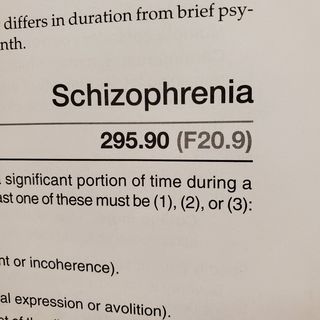Psychopharmacology
Why Is Clozapine Underused in Schizophrenia?
Clozapine is the most effective antipsychotic agent, but its use is declining.
Posted August 31, 2019
Schizophrenia can be a difficult-to-manage disease with roughly one-third of all patients developing treatment-resistance (Essali, Al-Haj Hassan, Li, & Rathbone, 2009). While various definitions of treatment-resistant (or refractory) schizophrenia exist, the concept can be broadly defined as a failure of at least two antipsychotic medications (Conley & Kelly, 2001). It is clear that treatment resistance in schizophrenia causes widespread suffering, disability, and economic burden, and it accounts for a sizable percentage of hospital admissions and readmissions.

While other strategies can be utilized in managing treatment-resistant schizophrenia, such as electroconvulsive therapy (Grover, Chakrabarti, Hazari, & Avasthi, 2017) and combining pharmacotherapy with intensive psychotherapy (Ruffalo, 2019; Hogarty et al., 2004; McWilliams, 2004; Arieti, 1974), the drug clozapine (brand name Clozaril) is widely recognized as treatment-of-choice in these cases. Robust evidence spanning three decades demonstrates clozapine's superiority to first-generation and other second-generation antipsychotic agents in the management of refractory schizophrenia (Leucht et al., 2009). The current consensus is that up to 60% of these patients show improvement with clozapine (Meltzer, 1997).
Yet, research indicates that clozapine is underutilized in the United States and in some other countries around the world (see Mistry & Osborn, 2011). My anecdotal experience is that the drug is used commonly in university-affiliated settings and on extended inpatient units, but is used much less frequently on general inpatient psychiatry units in private hospitals. One studied showed that clozapine use in the U.S. decreased from 11% of all second-generation antipsychotics in 1999 to 5% in 2002 (Kelly, Kreyenbuhl, Buchanan, & Malholtra, 2007).
The first atypical (or second-generation) antipsychotic, clozapine was approved for refractory schizophrenia by the Food and Drug Administration in 1989. Like some other psychiatric medications, such as lithium carbonate, clozapine use requires hematological monitoring to avoid possible adverse effects. About 3% of patients treated with clozapine develop neutropenia and about 0.8% develop agranulocytosis (Atkin et al., 1996), a potentially fatal lowering of the white blood cell count. Strict blood monitoring significantly reduces the risk of these adverse effects.
What accounts for the underuse of clozapine in the U.S. despite its well-established safety and effectiveness? A tendency on the part of the clinician to overestimate the prevalence and severity of clozapine's side effects has been documented (Hodge, 2008; Nielsen, Dahm, Lublin, & Taylor, 2010). Aggressive marketing of other, more lucrative second-generation antipsychotics by the pharmaceutical industry has also been offered as an explanation. The cost of blood monitoring is another issue, though it is clear that clozapine's use saves money long-term due to reduced frequency of hospitalization (Aitchison & Kerwin, 1997; Hayhurst, Brown, & Lewis, 2002).
Torrey (2016) examined the 7-fold difference in clozapine use among the U.S. states and concluded that there is a strong association between lower clozapine use and for-profit managed care. Since clozapine is initially more expensive to use than other antipsychotics but saves money in the long run by decreasing rehospitalizations, it seems that for-profit managed care companies are more interested in short-term profits than long-term cost savings.
My personal experience has been that older psychiatrists tend to utilize clozapine more often than younger psychiatrists, though I have no research to support this observation. This could be due to younger generations of psychiatrists feeling untrained or ill-equipped to prescribe clozapine, since its use has decreased significantly in recent years. A similar observation can be made about lithium, the "gold standard" in the treatment of bipolar disorder.
Since many of the psychiatric medications introduced since 2000 have been atypical antipsychotic agents, it seems, to me, that pharmaceutical company marketing has played a major role in the increased use of atypical antipsychotics in the management of bipolar illness and in the use of atypical antipsychotics other than clozapine in the treatment of schizophrenia.
When clozapine's underuse in schizophrenia is considered in tandem with the underutilization of lithium carbonate in bipolar disorder, it becomes apparent that large numbers of patients with serious mental illness are being provided less than optimal psychiatric care. As Torrey (2016) asks, is the pursuit of short-term profit impeding quality, evidence-based treatment? At least in the case of clozapine, the answer seems to be yes.
References
Aitchison, K. J., & Kerwin, R. W. (1997). Cost-effectiveness of clozapine. A UK clinic-based study. British Journal of Psychiatry, 171, 125-130.
Arieti, S. (1974). The interpretation of schizophrenia (2nd ed.). New York: Basic Books.
Atkin, K., Kendall, F., Gould, D., Freeman, H., Liberman, J., & O'Sullivan, D. (1996). Neutropenia and agranulocytosis in patients receiving clozapine in the UK and Ireland. British Journal of Psychiatry, 169(4), 483-488.
Conley, R., & Kelly, D. (2001). Management of treatment resistance in schizophrenia. Biological Psychiatry, 50(11), 898-911.
Essali, A., Al-Haj Hassan, N., Li, C., & Rathbone, J. (2009). Clozapine versus typical neuroleptic medication for schizophrenia. Cochrane Database of Systematic Reviews, 1.
Hayhurst, K. P., Brown, P., & Lewis, S. W. (2002). The cost-effectiveness of clozapine: A controlled, population-based, mirror-image study. Journal of Psychopharmacology, 16(2), 169-175.
Hodge, K., & Jesperson, S. (2008). Side-effects and treatment with clozapine: A comparison between the views of consumers and their clinicians. International Journal of Mental Health Nursing, 17(1), 2-8.
Hogarty, G. E., Flesher, S., Ulrich, R., Carter, M., Greenwald, D., Pogue-Geile, M., Kechavan, M., Cooley, S., DiBarry, A. L., Garrett, A., Parepally, H., & Zoretich, R. (2004). Cognitive enhancement therapy for schizophrenia: Effects of a 2-year randomized trial on cognition and behavior. Archives of General Psychiatry, 61(9), 866-876.
Kelly, D., Kreyenbuhl, J., Buchanan, R., & Malholtra, A. (2007). Why not clozapine? Clinical Schizophrenia & Related Psychoses, 1(1), 92-95.
Leucht, S., Komossa, K., Rummel-Kluge, C., Corves, C., Hunger, H., Schmid, F., Asenjo Lobos, C., Schwarz, S., & Davis, J. M. (2009). A meta-analysis of head-to-head comparisons of second-generation antipsychotics in the treatment of schizophrenia. American Journal of Psychiatry, 166(2), 152-163.
McWilliams, N. (2004). Psychoanalytic psychotherapy: A practitioner's guide. New York: Guilford Press.
Meltzer, H. (1997). Treatment resistant schizophrenia—the role of clozapine. Current Medical Research and Opinion, 14(1), 1-20.
Mistry H., & Osborn, D. (2011). Underuse of clozapine in treatment-resistant schizophrenia. Advances in Psychiatric Treatment, 17(4), 250-255.
Nielsen, J., Dahm, M., Lublin, H., & Taylor, D. (2010). Psychiatrists' attitude towards and knowledge of clozapine treatment. Journal of Psychopharmacology, 24(7), 965-971.
Ruffalo, M. L. (2019). Understanding schizophrenia: Towards a unified biological and psychodynamic approach. Psychoanalytic Social Work. Advance online publication. doi:10.1080/15228878.2019.1616570
Torrey, E. F. (2016). Why clozapine use varies by state. Psychiatric Times. Retrieved from https://www.psychiatrictimes.com/schizophrenia/why-clozapine-use-varies…


